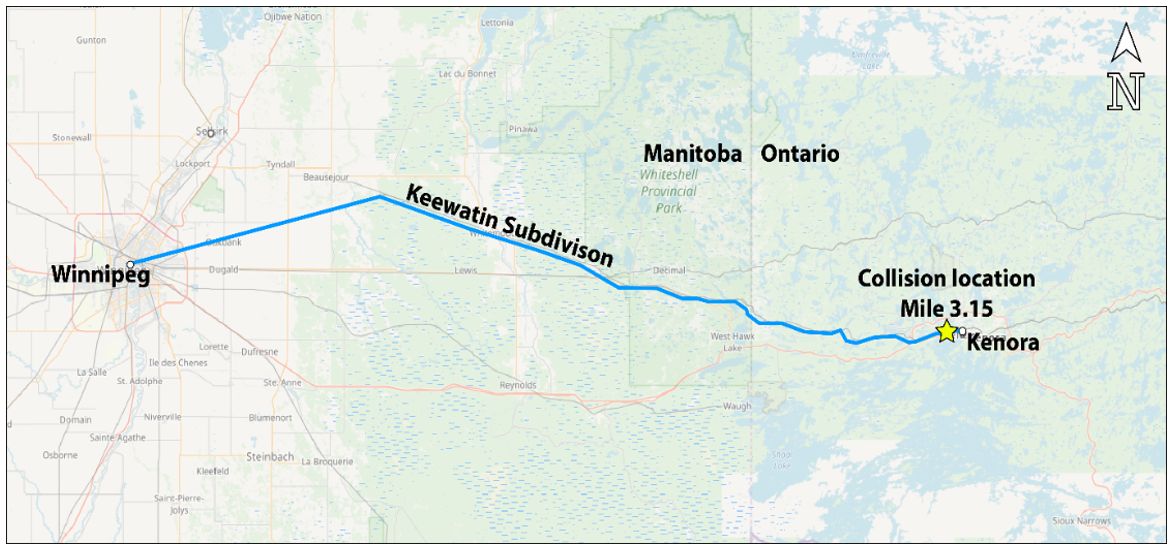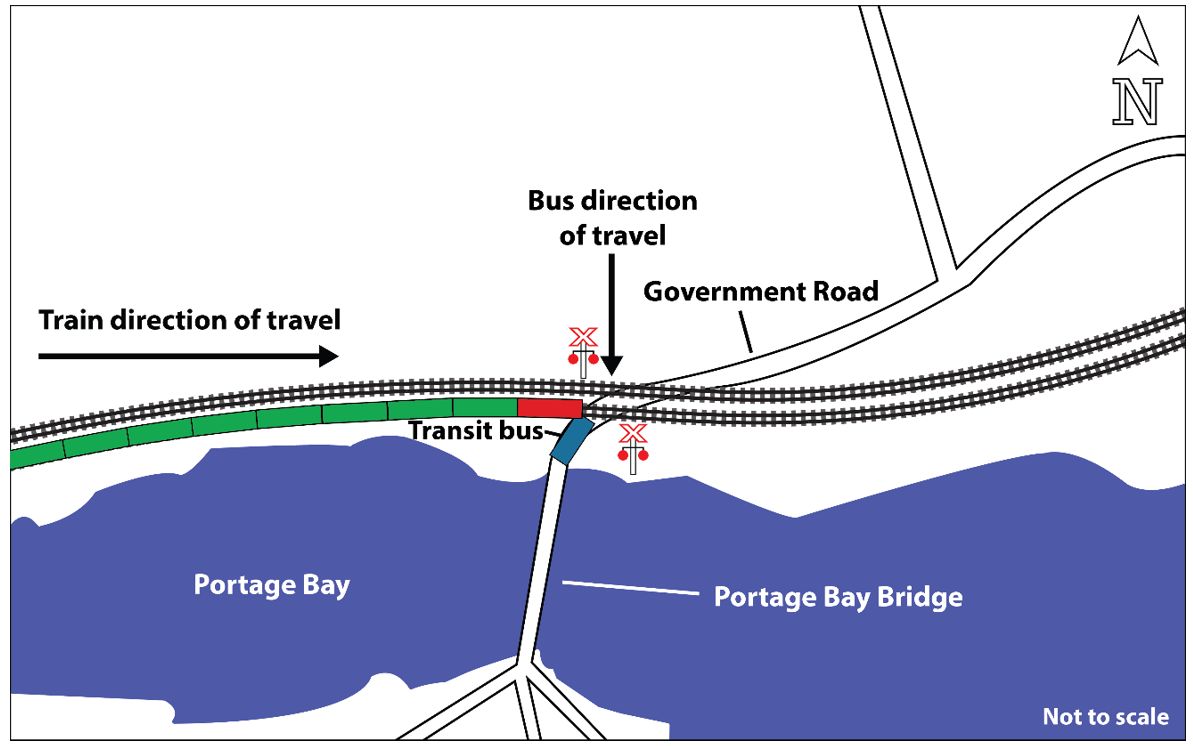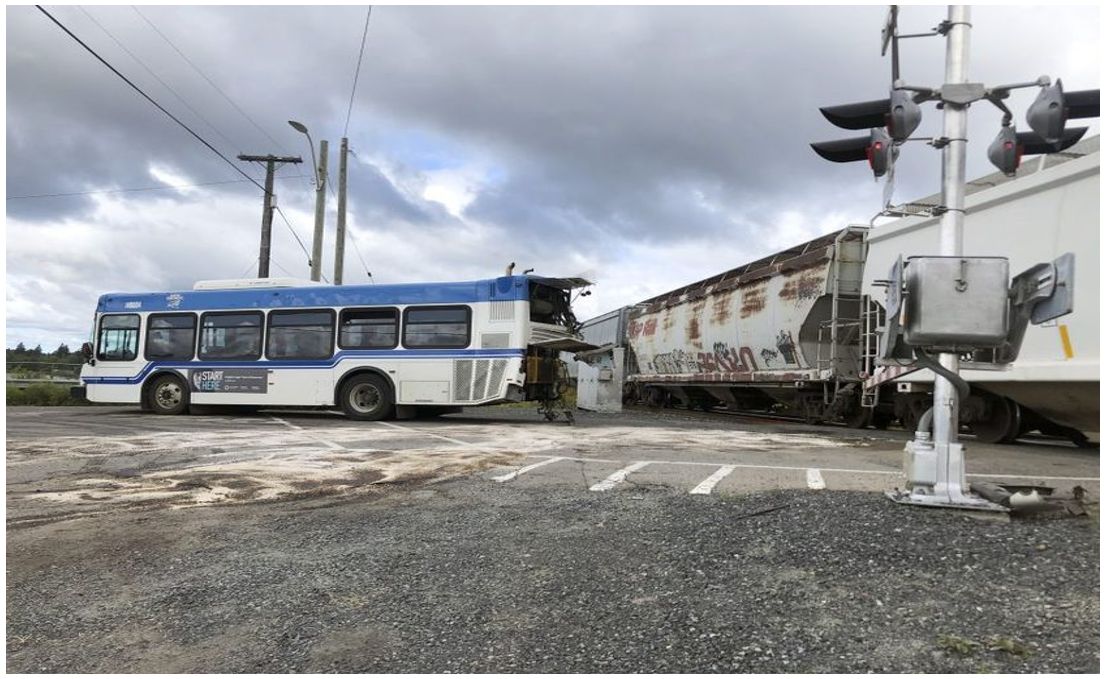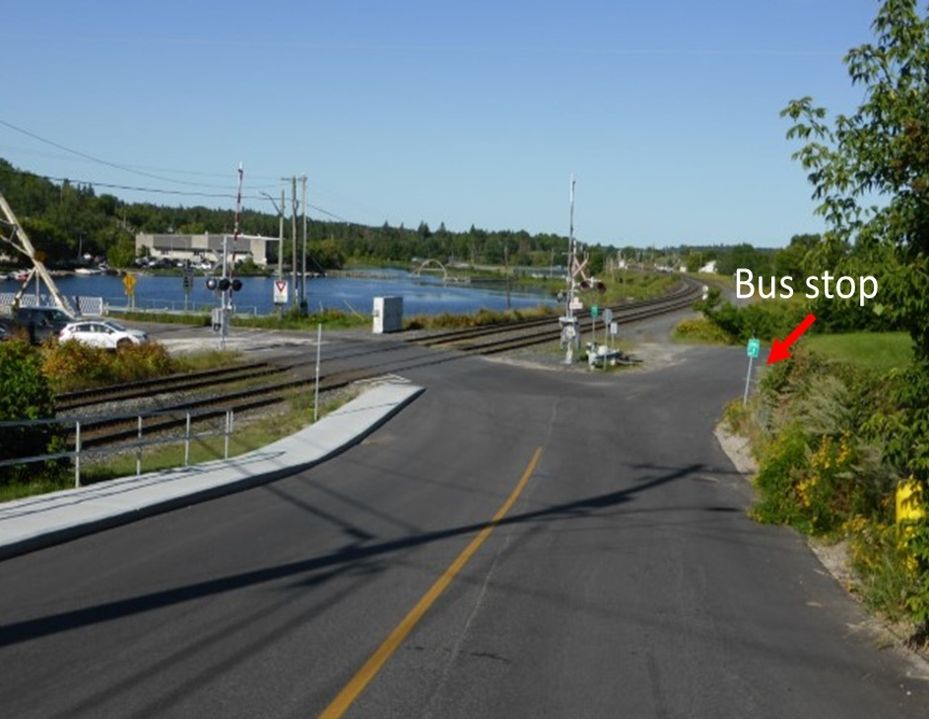Crossing collision
Freight train 320-173
City of Kenora transit bus
Mile 3.15, Keewatin Subdivision
Kenora, Ontario
The Transportation Safety Board of Canada (TSB) investigated this occurrence for the purpose of advancing transportation safety. It is not the function of the Board to assign fault or determine civil or criminal liability. This report is not created for use in the context of legal, disciplinary or other proceedings. See Ownership and use of content. Masculine pronouns and position titles may be used to signify all genders to comply with the Canadian Transportation Accident Investigation and Safety Board Act (S.C. 1989, c. 3).
The occurrence
On 08 August 2019, a Canadian Pacific Railway (CP) operating crew was ordered for 0240Footnote 1 in Winnipeg, Manitoba, for CP freight train 320-173, to operate on CP’s Keewatin Subdivision from Winnipeg (Mile 125.7) to Kenora, Ontario (Mile 0.0) (Figure 1). The operating crew consisted of a locomotive engineer and a conductor who were qualified for their positions, met fitness and rest requirements, and were familiar with the territory.
At 0506, the eastbound train departed Winnipeg. The train was powered by 2 locomotives—one at the head end and the other at the tail end. The train comprised 166 loaded freight cars and 1 empty car. It weighed 22 585 tons and was 9710 feet long.
At 0934, while proceeding at 37 mph on the south main track,Footnote 2 the train collided with the rear end of a City of Kenora transit bus, operating on the Keewatin bus route. The collision occurred at the Government Road public railway crossing in the City of Kenora, located at Mile 3.15 of CP’s Keewatin Subdivision (Figure 2). The crossing was protected by grade crossing warning devices (GCWD), which consisted of automated flashing lights, bell and gates. After traversing the crossing, the transit bus had stopped on Government Road with the right rear corner of the bus foul of the south main track.
As a result of the collision, the back end of the bus spun approximately 30 degrees before the bus came to a stop. The driver then pulled the bus forward approximately 10 feet and evacuated the 7 passengers to the side of the road. Ontario Provincial Police and paramedics were informed of the accident and attended the scene. The driver and passengers were assessed by the paramedics. There were no injuries.
Once the train came to a stop, it was blocking 3 crossings. The crossings were cleared later that morning.
At the time of the occurrence, there were scattered clouds with visibility of 32 km. The temperature was 15 °C, and the winds were from the north-northeast at 19 km/h.
Damage resulting from the collision
The bus sustained extensive damage to its right rear corner, including damage to the body, frame, and motor mounts (Figure 3). The lead locomotive of the freight train sustained minor damage to the right front handrails and steps of the boarding ladder.
Recorded information
The locomotive event recorder download was examined. It was determined that
- while approaching the crossing, the train was travelling at about 37 mph with the train brakes released and the throttle in idle;
- the train horn was sounded continuously for 19 seconds leading up to the crossing; and
- the train brakes were applied in emergency before the train reached the crossing.
The download from the crossing signal bungalow was reviewed following the occurrence. It was determined that
- the crossing bell and lights began to operate about 30 seconds before the train occupied the crossing;
- the crossing gates had descended fully before the train’s arrival; and
- the GCWD had activated and functioned as designed.
Road information
Government Road is a 2-lane asphalt paved roadway with a posted speed of 50 km/h in the vicinity of the crossing. Approaching the railway crossing from the east, the road runs parallel to the tracks with a descending grade. Near the crossing, the road turns south and traverses the tracks at a 60-degree angle to access the Portage Bay Bridge.
Bus information
The occurrence bus was a single-axle, heavy-duty transit bus, manufactured in 2014 by ElDorado (a subsidiary of REV Group) in the United States. The bus was equipped with an automatic transmission and had large side-view mirrors attached to the front pillars on its exterior. The bus weighed 17 500 kg and had a capacity of 29 passengers. The bus, owned by the City of Kenora, was being operated by First Student Canada under an operating agreement with the city. The bus was well maintained and was in generally good mechanical condition.
The bus was equipped with an in-vehicle video recorder located above and behind the driver’s left shoulder, positioned to record activities inside the bus in the vicinity of the driver and some of the roadway slightly ahead and to the right of the driver. The availability of in-vehicle video proved invaluable to helping establish the sequence of events, including the driver’s actions and where the driver’s visual attention was focused in the seconds leading up to the collision.
The bus was scheduled to arrive at this bus stop at 0931. The bus was only a few minutes late due to road construction delays in the vicinity, which was a daily occurrence.
Driver information and actions
The driver of the transit bus had been employed by First Student Canada for 8 years, driving both transit buses and school buses in Winnipeg and Kenora. The driver was in good health, had passed the annual medical evaluations, and was rested and fit for duty.
On the day of the occurrence, at about 0933, the bus was travelling south on the descending grade of Government Road approaching the city bus stop at the base of the road, just before the crossing (Figure 4). The driver observed a train approaching in the distance. The lights and bell at the crossing were activated, but the gates had not begun to descend. At that time, no passengers were waiting at the bus stop.
While making the left turn toward the crossing, the driver observed in the right side mirror 2 people rushing toward the city bus stop. Given the proximity of the bus to the crossing and the driver’s belief that there was sufficient space to stop on the south side of the tracks to pick up the 2 people, the driver decided to cross the tracks instead of making an abrupt stop at the crossing while there were passengers on board. The driver motioned with his right hand to indicate to the 2 people to proceed over the crossing in order to board the bus on the south side of the tracks.
At about the same time, a passenger using a cane stood up and moved forward in the bus trying to get the driver’s attention. The bus then completed the left turn and crossed the tracks before the crossing gates came down. The driver stopped the bus on the south side of the crossing, unaware that the rear end of the bus was foul of the south main track.
The driver opened the bus door at the front right side of the bus. Just as the 2 people entered the bus, the passenger with the cane tapped the driver on the shoulder to bring the driver’s attention to an open door on a small storage area located above the driver. The driver reached up to close the door and as he was doing so, the eastbound freight train collided with the right rear corner of the bus.
Ontario requirement to stop at railway crossings
Subsection 163(1) of the Ontario Highway Traffic Act states the following:
When the driver of a vehicle is approaching a railway crossing at a time when a clearly visible electrical or mechanical signal device or a flagman is giving warning of the approach of a railway train, he or she shall stop the vehicle not less than 5 metres from the nearest rail of the railway and shall not proceed until he or she can do so safely.Footnote 3
Distraction
In addition to the multiple visual cues in the vicinity of the crossing, the driver was distracted by the passenger with a cane who had stood up and was making his way forward. The driver’s concern for the standing passenger as the bus was coming to a stop further divided his attention while he was in the process of driving across the tracks and making a stop.
People have limited attention capabilities. Divided attention affects the amount of attentional resources a person can direct to a priority task. In this occurrence, the driver had completed the task of making a stop and assumed that the bus was completely clear of the tracks.
The bus was equipped with side mirrors that allowed the driver to view alongside and behind the bus. Due to the angle at which the road intersected the crossing, if the rear end of the bus fouled the tracks, it would have been more noticeable in the right side mirror. Although the driver had been looking in the right side mirror, he did not notice that the rear end of the bus was foul of the south main track. At that time, the driver’s visual attention was focused on the 2 people walking along the right side of the bus toward the front door.
Safety messages
It is important that all motor vehicle drivers stop at railway crossings as soon as there is warning of an approaching train.
When stopping near a crossing, it is important for motor vehicle drivers to visually confirm that the vehicle is clear of the railway tracks.
This report concludes the Transportation Safety Board of Canada’s investigation into this occurrence. The Board authorized the release of this report on 11 December 2019. It was officially released on 07 January 2020.
This report is the result of an investigation into a class 4 occurrence. See the Policy on Occurrence Classification.
Citation: Transportation Safety Board of Canada, Rail Transportation Safety Investigation Report R19W0236 (released 07 January 2020).



